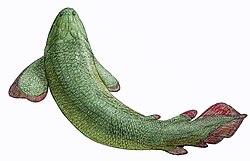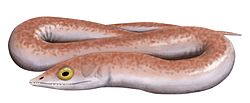| Sauripterus | |
|---|---|
 | |
| Scientific classification | |
| Domain: | Eukaryota |
| Kingdom: | Animalia |
| Phylum: | Chordata |
| Clade: | Sarcopterygii |
| Clade: | Tetrapodomorpha |
| Class: | † Rhizodontida |
| Order: | † Rhizodontiformes |
| Family: | † Rhizodontidae |
| Genus: | † Sauripterus Hall, 1843 |
| Type species | |
| †Sauritolepis taylori Hall, 1840 | |

Sauripterus ("lizard wing") is a genus of rhizodont lobe-finned fish that lived during the Devonian period. This genus was described by J. Hall after its discovery at Powy's Curve in the Catskill Formation of Pennsylvania, US. [1] Sauripterus utilized its radial joints and flexors to stiffen its fins, facilitating various swimming movements. [2]





